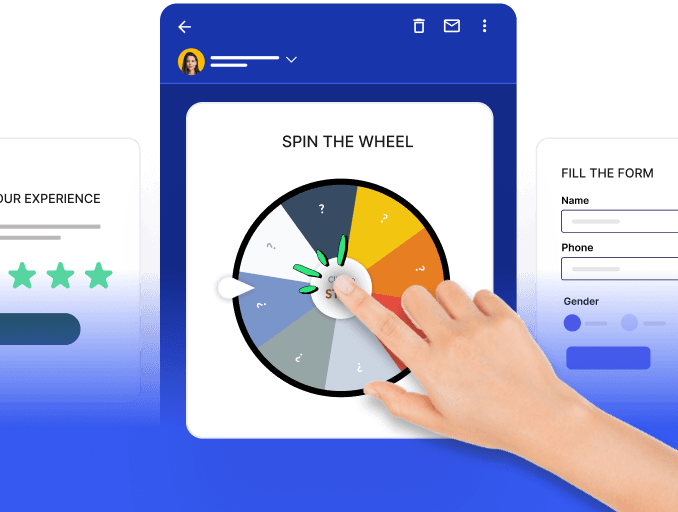Popup forms are effective tools for capturing visitors’ attention and generating leads and the option to choose from various types of popups make it an attractive option for businesses. However, the popup form design can significantly influence the effectiveness of these forms.
Popup form design is one of most crucial aspect of creating engaging interactions with website visitors, capturing leads, and driving conversions. In this guide, you will discover how to integrate design principles into each element of a popup form to increase the conversion rate of your popup forms.
Table of contents
What is popup form design?
A popup form design refers to the layout, appearance, and functionality of popup windows that appear on top of a website's content.
These windows prompt visitors to take specific actions, such as subscribing to a newsletter, accessing exclusive content, or completing a purchase. It is a common tool digital marketers use to capture leads, engage visitors, and drive conversions.
How do popups appear on the screen?
Popup form design significantly influences the appearance of popups on the screen and how users interact with them. Design elements like size, color, placement, and content affect popups' visibility, attractiveness, and usability. Here are some common ways popups appear on the screen:
Slide popup: It appears from the side of the screen, either left or right, and often provides additional information or options without obstructing the entire screen. It's useful for presenting contextual content or options while allowing users to still interact with the underlying interface.
Modal popup: overlays the entire screen and requires users to interact with it before returning to the main interface. It's commonly used for important messages, confirmations, or interactions that require immediate attention or user input.
Elements of the popup design
The best popup form design occurs when you start taking care of the fundamental elements that make up the popup. Let’s look at the elements one by one and explore how you can improve them.:
1. Layout
There are two major types of layouts: single-column layout and double-column layout.
Single-column layout suits simple popups with limited content, stacking elements vertically one below the other.
Double-column layout allows for a more structured popup, separating content and CTAs or forms into distinct columns.
Responsive layout is a combination of both and can adapt and adjust its appearance and behavior based on the device or screen size it is being viewed on.
How to design:
While designing single-column layouts, you ensure that content flows smoothly by establishing a clear hierarchy and prioritizing the most important information at the top.
In a multiple-column layout, look at distributing content and form fields across multiple columns, paying attention to logical grouping and information hierarchy.
A responsive layout should have appropriate breakpoints for different screen sizes and device types to ensure effective adaptation.
Implement fluid systems that help adapt to different screen sizes by using relative units like percentage or viewport units.
2. Title
The title conveys the main message or purpose of the popup. The heading styles are crucial in establishing a clear hierarchy and grabbing the user's attention. Here’s how you can approach the title and heading styles in designing the popup form:
Select a font that aligns with your application or website's overall branding and personality.
Use a bold or heavier font for the title to make it stand out from the rest of the content within the popup form. Increase the title's font size to create a visual hierarchy and ensure it's immediately noticeable, even at a glance.
Choose a color for the title that provides sufficient contrast with the background color, ensuring it's easily readable.
Position the title prominently at the top of the popup form, either centered or aligned with the overall layout.
If necessary, include a subtitle or brief description below the main title, using a smaller font size and a lighter weight to maintain the hierarchy.
This example shows how you can have a crisp and persuasive title within the popup form.
3. Subtitle
It provides additional context or information to support the title. Designing subtitles in the context of popup form design involves incorporating a small, unobtrusive text element that provides additional context or instructions to the user without cluttering the main form fields. Here are some considerations:
Position subtitles near the form field they correspond to, typically below the field label or within the input field itself.
Aim for a short sentence or phrase that provides the necessary context without overwhelming the user with too much information.
In responsive designs, subtitles should adjust their placement and formatting to remain legible and associated with the correct form field across different screen sizes and orientations.
In this example, You can see how the subtitle provides additional context to increase the effectiveness of the title.
4. Image
Visuals enhance the appeal and understanding of the message of your popups. When designing images for popup forms, it's important to consider their dimensions, formatting, and placement to create a cohesive and visually appealing experience. Here are some other key considerations:
Consider the image's aspect ratio within the popup form, the overall layout, and the available space to determine the appropriate size.
Adjust the image size and resolution to maintain clarity and sharpness, especially on high-resolution displays.
Use rounded corners to soften the image's appearance and make it more visually pleasing within the popup form.
Use drop shadows to add depth and dimension, making the image stand out from the background.
Use borders to provide a visual separation between the image and other elements, helping to organize the layout.
Align the image appropriately, centered, left-aligned, or right-aligned, depending on the overall design and content flow.
In this example, the popup showcases a GIF instead of a still image. By showing the incentive in action, it creates a semi-immersive experience.
5. Close button
Include a visible and easily accessible button to close the popup. When designing the close button for a popup form, it's essential to balance visibility, intuitive placement, and adherence to user expectations. Hiding the close button is a bad practice and leads to a bad user experience. Here are some key considerations:
Choose an easily recognizable shape, such as a circle or a square with a cross symbol inside.
Use a contrasting color for the close button that stands out against the background of the popup form. This will make it more visible and easily identifiable.
Apply hover and focus states to the close button to provide visual feedback when users interact. This includes changing the color, adding a subtle animation, or displaying a tooltip with the word "Close" for added clarity.
Position the close button in the top-right corner of the popup form, as this location aligns with common user expectations and conventions across various platforms and applications.
Maintain consistent close button placement across different popup forms or instances within your application or website.
Provide sufficient spacing between the close button and the edges of the popup form, as well as other elements like the title or content, as it prevents accidental clicks and ensures user accessibility.
Ensure that the close button is accessible via keyboard navigation. Users should be able to tab, navigate, and close the popup form using the Enter or Space key.
Adjust the close button's size, color, and styling to balance the popup form's overall visual hierarchy and design.
6.Call-to action (CTA)
CTAs are designed to be the central attraction for your popup forms. The entire purpose of your popup form is to make your users click on the CTA. When designing call-to-action (CTA) elements in a popup form, it is crucial to make them stand out and compelling to encourage users to take the desired action. Here are some ways to effectively implement CTA text and button styles:
- Button redirects:
They are commonly used as CTAs in popup forms. Upon clicking a button CTA redirects the user to a different page or location. For example, a popup form may have a "Learn More" or “Get Started” button that, when clicked, redirects the user to the next step in a process.
- Form CTA: It refers to the elements within the popup form itself, which encourage users to fill out and submit the form. These CTAs guide the users on what action to take within the form, such as “Submit Now’, “Sign up” and “Download Now”.
Here are some considerations when designing your CTAs:
CTA should be prominently displayed and stand out from the surrounding content. Use contrasting colors, whitespace, or strategic placement to make it highly visible.
The CTA text should be clear, concise, and action-oriented which can be implemented by using imperative language (e.g., "Buy Now," "Sign Up," "Learn More") to convey the desired action.
Position the CTA strategically, typically near the end of the content or in a prominent location where users are likely to look. Avoid placing it too high or too low on the page.
The CTA should be large enough to be easily clickable or tappable, especially on mobile devices. Maintain proper proportions and avoid making it too small or too large compared to other elements.
7. Thank you page or post-submission page:
Redirect users to a confirmation page after form submission. It’s essential to consider the post-submission experience for users as well as the pre-submission experience. Here are some best practices for implementing an effective post-submission page:
The post-submission page should clearly communicate that the action has been completed successfully with a message like "Thank You for Your Submission!" or "Your Information Has Been Received."
Depending on the form's nature, you may want to provide users with additional information or instructions on the post-submission page. This could include details about the next steps, estimated response times, or any relevant documentation or resources related to the submission.
Incorporate visuals or icons that reinforce the successful submission message, like a checkmark.
Implement tracking mechanisms to monitor user behavior. This data can inform future optimizations and improvements to your popup form design.
8. Visual appearance
The overall visual appearance of your popup form has a great impact on how well your form converts and how the different elements look with it. Maintaining consistent branding and visual elements is crucial for creating a cohesive and professional user experience. Here are some strategies to consider:
Background color: Ensure the background color aligns with the brand's color palette. You can use a semi-transparent or opaque background color that complements your website's overall color scheme while ensuring sufficient contrast with the form content.
Font sizes: Maintain consistent font sizes for each element within the overlay, following your brand's typography guidelines or design system.
Spacing between elements: Maintain consistent spacing between form elements, such as fields, labels, buttons, and other components, contributing to a clean and organized layout.
Modal container: The modal container houses the form content within the overlay and should have consistent styling, such as rounded corners, shadows, or borders, aligned with your brand's design language.
Form field styles: Maintain consistent styles for form fields, including input fields, dropdowns, checkboxes, and radio buttons, as well as the size, height and color of the form fields.
5 best practices for designing a good popup form
User design principles are paramount when creating effective and user-friendly popup form designs. Adhering to established user experience (UX) and user interface (UI) design principles can greatly impact the success and usability of your popup forms. Here are some of the best practices to follow for best results:
Usability and accessibility: Ensure that your popup forms are easy to use, understand, and interact with for all users, including those with disabilities or varying levels of technical proficiency. Use clear labeling, logical layout, adequate contrast, and keyboard accessibility to do this.
User expectations and familiarity: Follow commonly accepted user design principles and align your popup forms with user expectations and familiar patterns. This familiarity reduces cognitive load and helps users navigate and complete the forms more efficiently.
Attention and focus management: Popup forms inherently demand attention from users, and user design principles help manage this attention effectively. Maintain a visual hierarchy, whitespace, and minimalism to ensure that users can easily focus on the most important elements and actions within the popup form.
Error prevention and recovery: By incorporating validation, feedback, and clear error messages, you can guide users through the form-filling process, minimizing frustration and increasing the likelihood of successful form submissions.
Mobile and responsive design: With the prevalence of mobile devices, you must ensure that your popup forms are optimized for various screen sizes and input methods. Responsive design, touch-friendly interactions, and compact layouts provide a seamless experience.
Takeaways
The significance of exceptional popup form design cannot be overstated, as it is a balanced blend of aesthetics, usability, and strategic intent. With a deep understanding of user behavior, meticulous attention to detail, and a commitment to continuous improvement, you can consistently deliver seamless and delightful experiences that will help you cultivate trust, establish brand recognition, and ultimately set yourself apart in this highly competitive sector.







